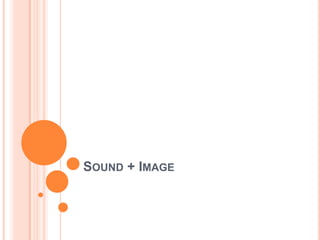
Sound unit day two
- 2. THE RELATIONSHIP BETWEEN SOUND AND IMAGE The sound and the image of a film can be recorded separately. This enables filmmakers to manipulate the sound to find the perfect balance between dialogue, music, and sound effects. Whichever element is emphasized helps the viewer understand what is important to the scene or the message the director is trying to convey.
- 4. Usually in a film, the sound will match what the audience sees on the screen.
- 5. THE RELATIONSHIP BETWEEN SOUND AND IMAGE By having the sound and image match, the filmmaker reinforces the reality of the movie world and shapes the viewer’s perception of the film. However, there are times when a filmmaker will purposely choose to have the sound differ from what is being shown onscreen.
- 6. THE RELATIONSHIP BETWEEN SOUND AND IMAGE There are five ways that sound may differ from the image: Onscreen space and offscreen space Objective images and subjective sound Diegetic details and non-diegetic sound Image time and sound time Image mood and sound mood
- 7. ONSCREEN SPACE AND OFFSCREEN SPACE Because the image is confined to the frame of the screen, filmmakers often try to find ways to make it seem as though the world of the film extends past the frame. One method of accomplishing this is to have sound come from offscreen – the area beyond the frame. A sound coming from offscreen means that it can be heard, but there is no image that shows us where the sound is coming from.
- 9. OBJECTIVE IMAGES AND SUBJECTIVE SOUNDS While the image is often limited to showing a character’s actions, through the use of subjective sound, a filmmaker can reveal to the viewer what a character is thinking. Although the audience can hear the sounds, they do not actually exist in the world of the movie.
- 11. DIEGETIC DETAILS AND NON-DIEGETIC SOUND Diegetic - Any sound, voice or piece of music that comes from within the world of the narrative Non-diegetic - Sounds, such as music or a narrator’s voices that come from outside the space of the narrative. When a filmmaker uses non-diegetic sound with an image from the world of the movie, it generally indicates a form of direct address to the audience. Examples: background music playing to shape the emotions of the audience, a voice-over narration
- 14. IMAGE TIME AND SOUND TIME Combining sound and image allows filmmakers to present two different points in time simultaneously. Example: when a voice-over narration describes past events. Sometimes discrepancies in image time and sound time occur during transitions, where the sound at the end of one scene will carry over into the other. This is called a sound bridge.
- 16. IMAGE MOOD AND SOUND MOOD Often, a film’s soundtrack corresponds to what is happening on the screen and serves to emphasize the mood of the image. By creating a contrast between the mood of the image and the mood of the sound, however, a filmmaker can highlight the tension of a scene and draw the audience’s attention to a particular aspect of the movie.